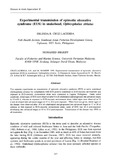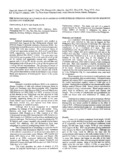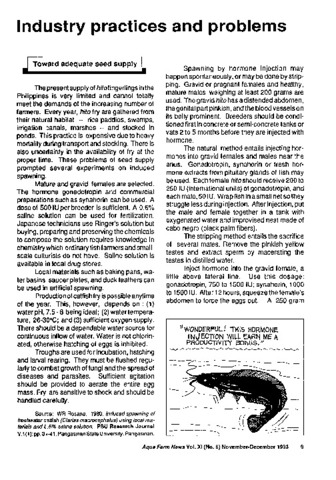ສະແດງບັນທຶກທີ່ງ່າຍດາຍສໍາລັບລາຍການ
Establishment of cell lines from catfish (Clarias batrachus) and snakeheads (Ophicephalus striatus)
Share
| dc.contributor.author | Lio-Po, Gilda D. | |
| dc.contributor.author | Traxler, G. S. | |
| dc.contributor.author | Albright, L. J. | |
| dc.date.accessioned | 2013-12-16T02:50:03Z | |
| dc.date.available | 2013-12-16T02:50:03Z | |
| dc.date.issued | 1999 | |
| dc.identifier.citation | Lio-Po, G. D., Traxler, G. S., & Albright, L. J. (1999). Establishment of cell lines from catfish (Clarias batrachus) and snakeheads (Ophicephalus striatus). Asian Fisheries Science, 12(4), 343–349. | en |
| dc.identifier.issn | 0116-6514 | |
| dc.identifier.uri | http://hdl.handle.net/10862/1839 | |
| dc.description.abstract | Primary cell cultures from catfish (Clarias batrachus) and snakeheads (Ophicephalus striatus) were prepared from whole fry and fingerling organ tissues of the brain, fins, gonad, heart, kidney, liver, skin and spleen. Four methods were tried: method A, wherein explants were placed onto the surface of 25-cm2 Primaria flasks (Falcon), allowed to attach for an hour before addition of Leibovitz medium (L-15) supplemented with 15% fetal bovine serum (FBS)(L15-15); Method B, wherein explants were inoculated into 25-cm2 Primaria flasks (Falcon) already containing L15-15; Method C, which required forcing minced organ sections through a stainless steel sieve with the aid of a syringe plunger into a petri dish containing L15-15 medium; and Method D, wherein immersed sections of minced tissues to 0.5% trypsin-EDTA were slowly agitated using a magnetic stirrer for one hour at 25°C. Method B was most effective in the establishment of cell cultures from both fish species. Passage numbers of the cells are to date catfish gonad (CFG) P-56, catfish heart (CFH) P-51, catfish kidney (CFK) P-7, catfish liver (CFL) P-8, catfish spleen (CFS) P-54, snakehead gonad (SHG) P-26, snakehead heart (SHH) P-22, snakehead kidney (SHK) P-19, snakehead liver (SHL) P-49 and snakehead spleen (SHS) P-76. Attempts to derive primary cell cultures from organ tissues of the brain, fins, skin and whole fry were unsuccessful. Established cells were fibroblastic. The cells grew rapidly and became confluent 24 h after seeding at 20 and 25°C. Both SHS and CFS were susceptible to a virus isolated from EUS-affected fish in the Philippines. The cells were best maintained at 20°C and stored in liquid nitrogen or -70°C. | en |
| dc.description.sponsorship | The authors wish to thank the Aquaculture Department, Southeast Asian Fisheries Development Center and the International Development Research Centre (IDRC) of Canada (Fish Microbiology Project 3-P-88-1053-02) for funding support. Appreciation is also due to Dr. R. Hedrick, Univ. Calif.-Davis, for his technical suggestions and to Dr. K. Tonguthai through the SEAFDEC Project for funding assistance in attending the 5th Asian Fisheries Forum held in Chiangmai, Thailand, in Nov. 1998. | en |
| dc.language.iso | en | en |
| dc.publisher | Asian Fisheries Society | en |
| dc.relation.uri | http://www.asianfisheriessociety.org/publication/pdf/0408672001355820748.pdf | |
| dc.subject | Clarias batrachus | en |
| dc.subject | Channa striatus | en |
| dc.title | Establishment of cell lines from catfish (Clarias batrachus) and snakeheads (Ophicephalus striatus) | en |
| dc.type | Article | en |
| dc.citation.volume | 12 | |
| dc.citation.issue | 4 | |
| dc.citation.spage | 343 | |
| dc.citation.epage | 349 | |
| dc.citation.journalTitle | Asian Fisheries Science | en |
| dc.subject.asfa | cell culture | en |
| dc.subject.asfa | disease resistance | en |
| dc.subject.asfa | fish diseases | en |
| dc.subject.asfa | tissue culture | en |
| dc.subject.scientificName | Ophicephalus striatus | |
| dc.subject.scientificName | Channa striata |
ໄຟລ໌ສໍາລັບລາຍການນີ້
| ໄຟລ໌ | ຂະໜາດ | ຮູບແບບ | ຊອກຫາ |
|---|
ລາຍການນີ້ເປັນຂອງຄໍເລັກຊັນຕໍ່ໄປນີ້
-
AQD Journal Articles [1223]
These papers were contributed by AQD staff to various national and international journals



